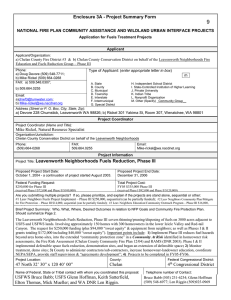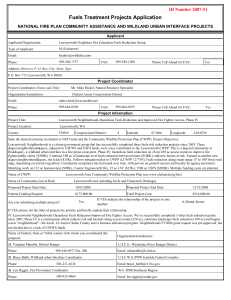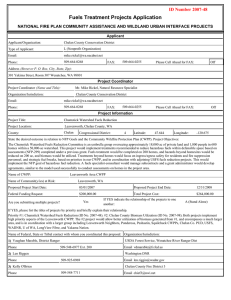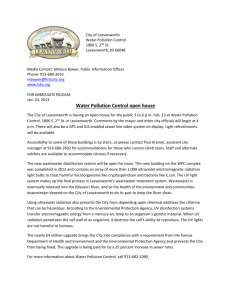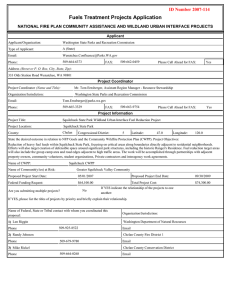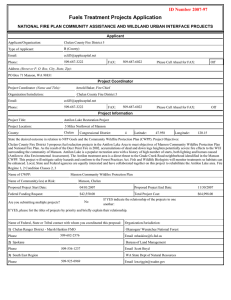Project Summary Form Id Number 2006-195
advertisement
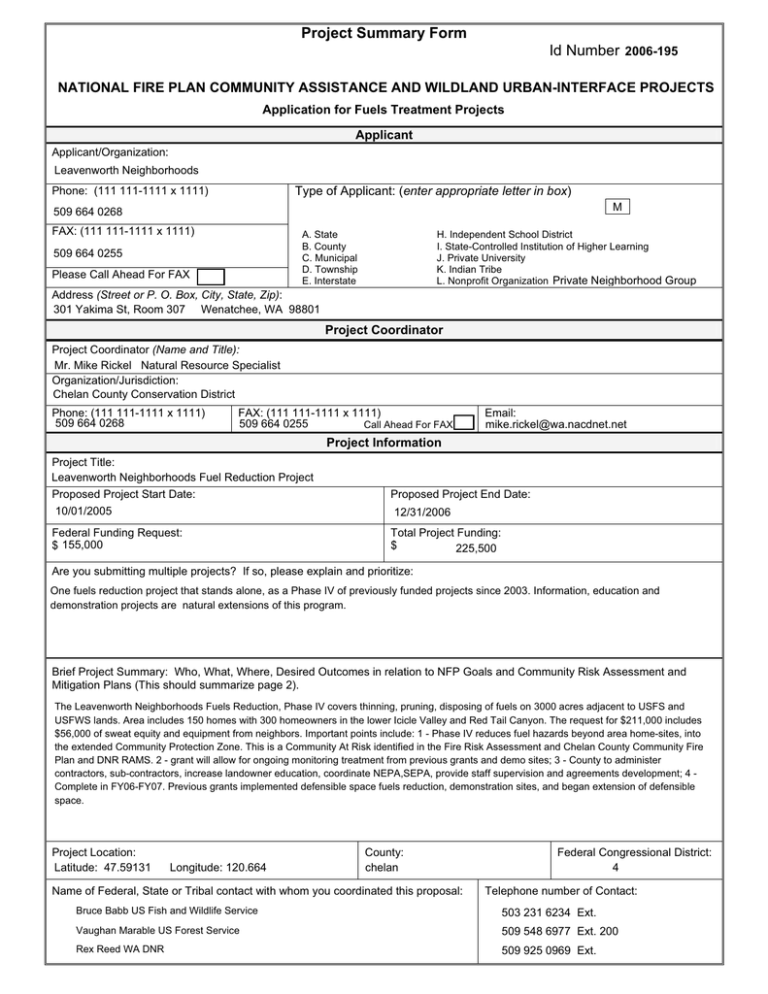
Project Summary Form Id Number 2006-195 NATIONAL FIRE PLAN COMMUNITY ASSISTANCE AND WILDLAND URBAN-INTERFACE PROJECTS Application for Fuels Treatment Projects Applicant Applicant/Organization: Leavenworth Neighborhoods Phone: (111 111-1111 x 1111) Type of Applicant: (enter appropriate letter in box) M 509 664 0268 FAX: (111 111-1111 x 1111) A. State B. County C. Municipal D. Township E. Interstate 509 664 0255 Please Call Ahead For FAX H. Independent School District I. State-Controlled Institution of Higher Learning J. Private University K. Indian Tribe L. Nonprofit Organization Private Neighborhood Group Address (Street or P. O. Box, City, State, Zip): 301 Yakima St, Room 307 Wenatchee, WA 98801 Project Coordinator Project Coordinator (Name and Title): Mr. Mike Rickel Natural Resource Specialist Organization/Jurisdiction: Chelan County Conservation District Phone: (111 111-1111 x 1111) 509 664 0268 FAX: (111 111-1111 x 1111) 509 664 0255 Call Ahead For FAX Email: mike.rickel@wa.nacdnet.net Project Information Project Title: Leavenworth Neighborhoods Fuel Reduction Project Proposed Project Start Date: 10/01/2005 Federal Funding Request: $ 155,000 Proposed Project End Date: 12/31/2006 Total Project Funding: $ 225,500 Are you submitting multiple projects? If so, please explain and prioritize: One fuels reduction project that stands alone, as a Phase IV of previously funded projects since 2003. Information, education and demonstration projects are natural extensions of this program. Brief Project Summary: Who, What, Where, Desired Outcomes in relation to NFP Goals and Community Risk Assessment and Mitigation Plans (This should summarize page 2). The Leavenworth Neighborhoods Fuels Reduction, Phase IV covers thinning, pruning, disposing of fuels on 3000 acres adjacent to USFS and USFWS lands. Area includes 150 homes with 300 homeowners in the lower Icicle Valley and Red Tail Canyon. The request for $211,000 includes $56,000 of sweat equity and equipment from neighbors. Important points include: 1 - Phase IV reduces fuel hazards beyond area home-sites, into the extended Community Protection Zone. This is a Community At Risk identified in the Fire Risk Assessment and Chelan County Community Fire Plan and DNR RAMS. 2 - grant will allow for ongoing monitoring treatment from previous grants and demo sites; 3 - County to administer contractors, sub-contractors, increase landowner education, coordinate NEPA,SEPA, provide staff supervision and agreements development; 4 Complete in FY06-FY07. Previous grants implemented defensible space fuels reduction, demonstration sites, and began extension of defensible space. Project Location: Latitude: 47.59131 Longitude: 120.664 County: chelan Name of Federal, State or Tribal contact with whom you coordinated this proposal: Federal Congressional District: 4 Telephone number of Contact: Bruce Babb US Fish and Wildlife Service 503 231 6234 Ext. Vaughan Marable US Forest Service 509 548 6977 Ext. 200 Rex Reed WA DNR 509 925 0969 Ext. Project Narrative Description Applications for funding must include a narrative response that describes the proposal. Please do not submit responses longer than one page, single space, 12-pitch font. Describe project including, but not limited to: x project relationship to the community risk assessment and x project location (e.g., Watershed, Address mitigation plan neighboring community) these items as applicable: x anticipated outcomes x amount or extent of actions (acres, number of homes, etc.) x project timeline and matching or contributed funds x community partners and their role(s) x proponent’s ability to complete project For this project, explain the level of cooperation, coordination or strategic planning, through a “Local Coordination Group.” If you have not worked with a local coordination group, why not? High level of cooperation and coordination in planning with USFWS, USFS, FPD, CCCD and landowners. Is this project adjacent to a current prescribed burn project on federal lands or to one that is planned within the next three years? (Yes/No) Yes Please indicate planned treatments and associated acres: * Treatment Thinning Acres 150 Treatment Hand Piling Acres 150 Treatment Clipping Acres 150 Treatment Hand Pile Burning Acres 150 If you have a treatment type other than standard types above: Chipping fuels Other 1 Pruning trees brush Acres 50 Other 2 Acres 50 Project Location: The LEAVENWORTH NEIGHBORHOODS is located in the Wenatchee River Basin, lower Icicle, Peshastin and Chumstick subwatersheds, the City of Leavenworth, a Community At Risk, adjacent to USFS and USFWS lands. Anticipated outcomes: The risk of wildfire will be reduced on a total of 3,000 acres resulting in a landscape approach to fuels reduction and forest health. An important goal will be to connect previous treatments. Additional emphasis will be for homeowner safety and firefighter access and evacuation routes such as roads and driveways. Individual landowners will continue risk reduction, including long-term thinning and pruning maintenance. Additional goals will be to contribute to the overall CWPP for the entire fire protection district and connect to adjacent community and governmental treatment work. Community partners and their role: Continue the partnerships that have been established since 2003 with the USFWS, USFS, Washington DNR, Chelan County Commissioners, the county Conservation District, the Chelan County Fire District, and others. The USFWS continues to provide direction and support. The USFS continues providing GIS, equipment, office space and expertise. The DNR continues to provide cooperative support and Forest Practices Application assistance. The Chelan County Fire District continues to supply vehicles, office space and personnel. The Chelan County Conservation District continues to provide contract administration, supervision, and budget management. Project relationship to the community risk assessment and mitigation plan: Leavenworth is a Community At Risk, the neighborhoods identified are within 1.5 miles of federal lands. The fire return intervals within the project area are from 2 to 30 years, with known fires occurring in 1965, 1994, and 2000. On Federal lands adjacent to the project area both the Forest Service, Boundary Butte EA, and the Fish and Wildlife Service, Leavenworth National Fish Hatchery EA, have actively conducted fuels reduction. The team completed risk assessments on 125 landowners home sites within the grant area. This has contributed to completion of a County-wide Fire Risk Assessment. The Leavenworth Neighborhoods group will continue to contribute funding and effort to the local fire protection district CWPP. Amount or Extent of Actions: The Leavenworth Neighborhoods group has a proven track record. Assessments on 125 homes within the 3000-acre area have been completed using NFPA form 299. All homes, roads, and driveways were mapped using GIS, and are now part of the local fire districts structure-protection plan. Sixty-seven private land owners have already implemented fuels reduction on approximately 200 acres around their homes. Three demonstration sites open to the public showing low, moderate, and high fuels reduction will be completed in spring 2005. The Leavenworth Neighborhoods group has assisted other groups organize and conduct assessments. The steering committee is a unique model for organization and implementation. Educational actions include not only the demonstration projects but community outreach to other groups across the county and state through personal contacts and media. The Leavenworth Neighborhoods group was the model used by the USFWS national training film. We are committed to continuing these efforts. Project timeline and matching or contributed funds: This Neighborhood Project is Phase IV, a continuation of previous phases beginning in 2003. Implementation will begin in October 2005 or when funding is appropriated. The project should be completed in two field seasons. Project Evaluation Criteria Applications for funding must include narrative responses that address the following three criteria. Be sure you address every one briefly, yet thoroughly. Limit your responses to the area provided. 1. Reducing Hazardous Fuels (50 points) A. Describe the community infrastructure that will be protected. B. Explain how the proposal reduces fire behavior in high hazard areas by describing the fuels to be disposed or removed, and the techniques and timing of the treatments. C. How will the proposed treatments be maintained in future years? D. How will you use multi-party monitoring to improve this and future projects? Response: Describe the Community Infrastructure that will be protected: Fire protection will be improved for approximately 250 homes and businesses. Ingress and egress routes that support fire suppression and resident evacuation will also be treated. A major water source which provides irrigation for local orchards will be protected. Adjacent properties include the town of Leavenworth and the Leavenworth National Fish Hatchery. Explain how the proposal reduces fire behavior in high hazard areas by describing the fuels to be disposed or removed, and the techniques and timing of the treatments: Extension of previous treatments for defensible spaces will be the highest priority. This includes high-hazard areas identified in risk assessments such as access routes, safety zones, and shaded fuel breaks. Continuous fuel areas such as dense forest and brush stands and ladder fuels will be treated. Treatments include cutting, pruning, brushing, and removal by chipping or hand-pile burning. This proposal develops the Leavenworth Neighborhood landscape protection plan to identify high priority areas outside of homesite defensible spaces. The objectives are risk reduction and prioritizing landowner sites for treatment. NEPA, SEPA and Washington State Forest Practices Applications as needed for larger tree removal, will be completed by the contract coordinator. Endangered Species Act assessments, Cultural Resource/Archaeological assessments, and State Forest Practices Applications may be needed. Wildlife habitat, sensitive plant and riparian needs will be reviewed with individual land owners, meeting Threatened and Endangered nesting-habitat requirements, as well as stream, soils, plant, and cultural resource protection. How will the proposed treatments be maintained in future years: The landowners will continue maintaining their properties as per the individual agreement with Chelan County Conservation District for fuels treatments. The fuels maintenance will be continued either through individual landowner efforts or through use of local contractors, who have become instrumental to this project. Additional agreements with the county and local fire district to maintain roads will be pursued. How will you use multi-party monitoring to improve this and future projects? The Leavenworth Neighborhoods area has been continually used for governmental agencies field trips to display examples of fire fuel reduction projects. We anticipate this to process to continue over time. From inception, the Leavenworth Neighborhoods group has had the goal of helping other neighborhoods get grants and reduce fires; as this occurs, we will have been successful. Actual fuels monitoring consists of before-and-after photographs, demonstration site signs, periodic project review, and landowner evaluation. The real monitoring will be when the next forest fire approaches the grant area. Project Evaluation Criteria 2. Increasing Local Capacity (25 points) A. How would the proposal improve or lead to the improvement of the local economy in terms of jobs and sustainable economic activity? B. How many jobs are expected to be created or retained and for how long? (Please distinguish between essentially year-round and seasonal jobs). C. What tools and skills will be gained or utilized as a result of this project? D. Will biomass be utilized; if so, in what manner and how much? Response: A. As a result of previous grants for Leavenworth Neighborhoods, the local economy has increased the number of qualified, small subcontractors who implement thinning, pruning, pile-stacking and burning, tree removal and topping, and chipping. B. There are 20 local, qualified subcontractors on the county list for landowners use. In addition, professional fire ecology, forestry, NEPA specialists will have opportunities for jobs. Four individuals and five contracting crews were employed in Phase I and II for assessments, fuels reduction, or contract administration. Fuels reduction work has already created over 30 seasonal jobs. Professional work may provide up to 10 jobs, of which one or two may be year-round. C. The public living within this fire-adapted ecosystem will become more aware of how to maintain forest health and reduce fire hazards. There will be a higher number of specialized and experienced subcontractors available throughout the county for fuels reduction. D. The smaller diameter biomass, under 8-inch diameter, will be chipped or piled and burned. There are presently no local markets for biomass utilization. Future air quality constraints may provide incentives for new product technology. Larger trees that have had NEPA or SEPA completed may be sold to mills for cost of haul, with extra profits going back into the program. 3. Demonstrating Community and Intergovernmental Collaboration (25 Points) A. How will this project implement a community risk assessment and mitigation plan? Include name of plan, date it was prepared, and local contact to get a copy of the plan if requested. B. How has this treatment been coordinated with adjacent landowners and local/State/Tribal/Federal agencies? C. Identify the cooperators/partners involved in implementation of this project. D. Describe the extent of current local support for the project, including any cost-sharing agreements. Response: A. The group has provided the information for the completion of the Chelan County risk assessment plan. This plan was completed in 2004; contact is Mike Rickel. The Chelan County CWPP for FPD 3 will be used in 2005. Contact is Kelly OBrien. Risk assessments for individual homes within the grant area have been completed and are available from the grantee. B. There has been coordination between the steering committee and an adjacent group for the past three years to coordinate proposed treatments and demonstration areas. Coordination also continues with USFWS, USFS, CCCD, Fire District 3, DNR and landowners. Field reviews have been done in the grant area with local, State, tribal and federal agencies. C. Partners include: the 150 homeowners and additional landowners as participants and matching funds; the USFS provides expertise, equipment, analysis and consultation; the National Fish Hatchery provides expertise and consultation; the DNR as advisor; the County Fire District with logistical support, direction, supervision; and the Chelan County Conservation District with budget management. D. Cooperation has been ideal, with open free discussions and proactive actions, it is expected to continue. The citizens on the Steering Committee are all volunteers; contributing assistance to the wildfire community and helping other groups get started. We are working together for a common goal. The Leavenworth Neighborhood landowners estimated completing fuels reduction on private lands as sweat equity. Phase I and Phase II accounted for $40,000 of matching funds, Phase III matched $34,000, and this Phase IV estimates approximately $50,000 per year. News and radio finds this project of interest. There is strong community support for this project. Project Work Form Tasks Time Frame Interagency Agreement for dispersal of funds, budgetary coordination. Responsible Party Chelan County Conservaton District and granting agency. Oct 2005 - Dec 2006 Neighborhood landscape Fire Plan completion on 3000 acres: field validate vegetation maps; risk assessment maps; SEPA and FPA; and prioritizing. Steering Committee review contracts, supply direction to contractors, subcontractors and agency as needed. Implementation contractor for fuels reduction recommendations, coordinating subcontractors, meeting with homeowners, complying with NEPA,SEPA,FPA. Mar 2005 - May 2006 Mar 2005 - Dec 2006 Contractor, Subcontractor and landowners working with Chelan County Conservation District and under direction of USFS and CCFPD. Leavenworth Neighborhoods Steering Committee of 6 Members from landowner group, 1 member from CCCD, CCFD, USFS. Oct 2005 - Dec 2006 Local contractors selected by Chelan County Conservation District and Steering Committee. Jan 2005 - May 2005 Chelan County Conservation District and USFS and CCFD, review with Steering Committee as needed. Oct 2005 - Dec 2006 Contractor and subcontractor with review by Steering Committee and other interested parties. Community Wildfire Protection Plan completion. Monitor fuels reduction from Phase I, II, III and IV, including demo sites. Public education and communications. Steering committee with contractors and agencies. Oct 2005 - Dec 2006 Project Budget USFWS/USFS Cost Category Description Federal Agency Applicant CCFD#3 Partner 1 Partner 2 Total Partner 3 Personnel Steering Committee Administrator CCCD Subtotal $9,000 $1,000 $1,000 $0 $6,000 $0 $5,000 $2,000 $0 $13,000 $6,000 $9,000 $6,000 $3,000 $0 $24,000 $0 $0 $0 $0 $11,000 Fringe Benefits Subtotal $0 $0 $0 $0 $0 $0 $0 $0 $0 $0 $0 $0 $0 $0 $0 $0 $0 $0 $0 $0 $0 $0 $0 $0 $0 $0 $0 $0 $0 $0 $0 $0 $300 $0 $500 $0 $0 $800 $300 $0 $0 $1,000 $0 $1,300 $600 $0 $500 $1,000 $0 $2,100 $600 $0 $500 $500 $0 $1,600 $0 $0 $0 $0 $0 $0 $600 $0 $500 $500 $0 $1,600 $23,000 $0 $0 $0 $0 $23,000 $104,300 $50,000 $50,000 $0 $0 $0 $154,300 $127,300 $0 $0 $0 $177,300 $15,500 $0 $0 $0 $0 $15,500 $5,000 $0 $0 $0 $5,000 $20,500 $0 $0 $0 $0 $0 $20,500 $155,000 $59,000 $7,000 $4,500 $0 $225,500 $0 $0 $0 $0 $0 $0 Travel $0 Subtotal Equipment GIS Computers Misc Subtotal Supplies Maps, mailings, etc. Subtotal Contractual Contract Coordinator Sub-contractors Subtotal Other Administrative Overhead CWPP Subtotal Total Costs Project (Program) Income1 ___________________________________ 1 Program income is the gross revenue generated by a grant or cooperative agreement supported activity during the life of the grant. Program income can be made by recipients from fees charged for conference or workshop attendance, from rental fees earned from renting out real property or equipment acquired with grant or cooperative agreement funds, or from the sale of commodities or items developed under the grant or cooperative agreement. The use of Program Income during the project period may require prior approval by the granting agency.
